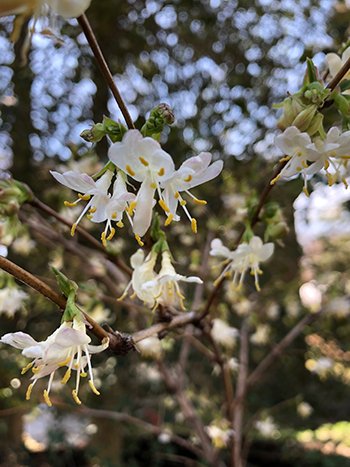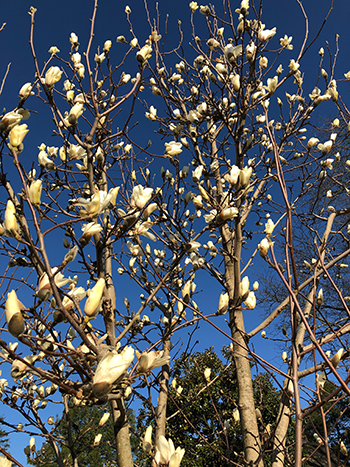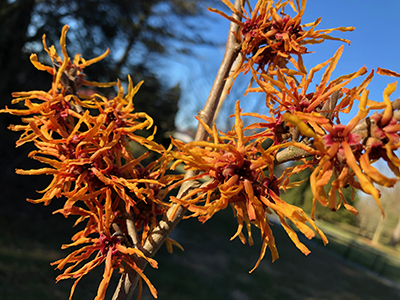
Plants of the Week: March 25

Lonicera x purpusii is a rather obscure member of Caprifoliaceae, the honeysuckle family. This is likely due to the woody shrubs rather unkempt demeanor. Even so, the family trait of lax growing habits shouldn’t exclude this deliciously fragrant winter bloomer from the garden.Between late February through March it is covered in clusters of white, tubular flowers with prominent yellow anthers.
Unlike many of its relatives, Lonicera x purpusii grows as a bush, rather than a climber. It has an arching habit and will grow about five feet tall, with a spread of approximately six feet across. It can be pruned after flowering, but it will look its best if its branches are thinned by up to a third rather than cut back. It prefers sun or semi-shade in well-drained soil.
Lonicera x purpusii is a cross between Lonicera fragrantissima and Lonicera standishii, produced in the 1920s in Darmstadt Botanic Garden in Germany. The species name pays tribute to two German brothers: Carl Albert Purpus and Joseph Anton Purpus. Together they collected plants from Mexico and the western United States.
Once Lonicera × purpusii has finished flowering it is easily forgotten. For this reason it is often planted at the back of the border. Combine it with shrubs that look good in summer but don’t plant it too far away from a path, where its winter beauty and scent can be appreciated. Photo credit: J. Coceano

The Yulan magnolia, Magnolia denudata, is a small tree typically reaching 30’ – 40’ tall with fragrant goblet-shaped white flowers that emerge before the leaves unfurl. The specific epithet meaning “bare” or “naked” alludes to this characteristic. While this trait provides for a spectacular floral display, it does put it at risk from spring frost damage.
Magnolia denudata ‘Fran Smith’ sports flowers typical of the species but has boldly variegated leaves with random cream and white splashes. The variegation is retained throughout the summer months. A 2001 accession is growing in front of the Ben West House. Photo credit: J. Coceano

While there is a multitude of information pertaining to Hamamelis x intermedia and the numerous cultivars that have resulted from the crosses between H. mollis and H. japonica, there is little information regarding the cultivar ‘Arnhem’. Located in the eastern part of the Netherlands, Arnhem is the capital of the province of Gelderland and is located on both banks of the rivers Nederrijn and Sint-Jansbeek.
‘Arnhem’ is an exceptionally long-flowering witchhazel. The flowers, a bright orange with a hint of red, open a bit later compared to other H. x intermedia cultivars. While we often desire the first bloom, it is equally nice to have cultivars that help the show last just a bit longer. A specimen can be seen along Hickory Walk in the Pinetum. Photo credit: J. Coceano





No Comments